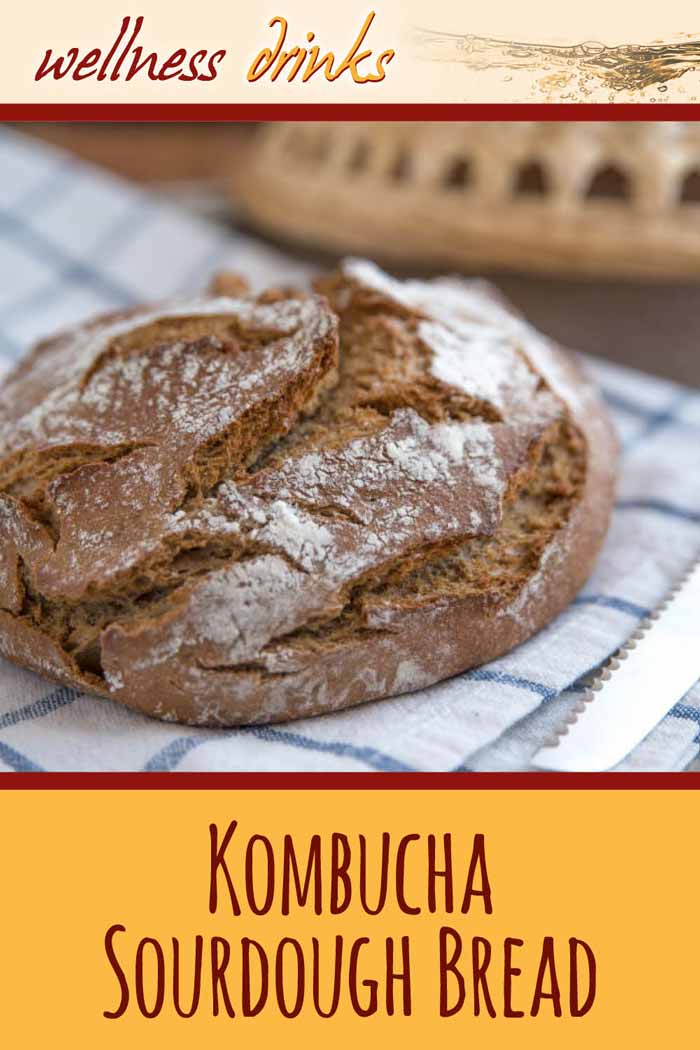Kombucha Sourdough Bread

Sourdough is something delicious and wonderful! Just like Kombucha and Kefir, sourdough contains a vital biocoenosis of bacteria and yeast fungi, which man has used for thousands of years to produce cereal flat bread and bread. Sourdough is particularly tasty because the metabolic products of its microorganisms significantly improve the dough: it becomes looser, more digestible, more aromatic, and the finished bread stays fresh much longer.
Sourdough is wonderful because it is made all by itself! The lactic acid bacteria and yeasts of which it is composed are found everywhere in our environment and also in the flour used. Sourdough therefore forms quite reliably and spontaneously if the same amount of flour and water is mixed and left to rest covered for two days. If the dough then smells pleasantly acidic, often with a fruity note, it can be assumed that the "good" bacteria and yeasts have prevailed. Especially whole grain breads clearly get a better consistency and quality through this spontaneous form of fermentation!
Just like the fermentation of raw vegetables, sourdough fermentation starts even better and faster if an existing starter culture is added. (By the way, you can find our Sourdough starter culture here in our shop.)
In our recipe for an incredibly crispy home-baked bread, fresh Kombucha serves as a starter culture - you won't believe it! If you make your own Kombucha at home with the Kombucha scoby of Wellness-Drinks , you should definitely try this recipe. We love it! :-)

The ingredients for Kombucha sourdough bread:
- 600 g wholemeal spelt flour
- 600 ml Kombucha (produced according to our Kombucha basic recipe)
- 4 tablespoons oat flakes
- 1 tablespoon flea seeds or coconut flour
- 1 tablespoon bread spice
- 3 teaspoons raw cane sugar
- 1-2 teaspoons salt
- 3 tablespoons olive oil or coconut oil
- 1 package of dry yeast or half a cube of fresh yeast
- 4 tablespoons roasted sunflower seeds
- 1 tablespoon apple vinegar
- Mix the spelt flour and Kombucha well and leave to rest for 48 hours at room temperature, covered.
- Add the other ingredients and mix well to a smooth dough.
- Leave to rest for an hour, then knead briefly and place in a bread tin. Let it rest for another two hours.
- Bake for 15 minutes at 230 degrees, then bake for about 45 minutes at 200 degrees.
Our tip: The rest periods are very important for the dough and the quality of the finished sourdough bread and should not be shortened. This is because the bacteria and yeasts in the dough work diligently to break down the various ingredients of the dough with the help of enzymes and make them easier to digest. Sourdough bread is therefore rightly regarded as particularly easy to digest and well tolerated.
In large industrial bakeries, bread doughs are often not given the time they actually need (dough rest) and prefer to work with synthetic enzymes and accelerators in order to reduce costs. Many digestive problems, which are often attributed to gluten intolerance, are actually due to the fact that the necessary dough rest was not maintained.
Sourdough bread is the ideal alternative here and definitely worth trying for those who have difficulties with bread. In addition, sourdough bread tastes great even after days and has a particularly delicious texture even when toasted.
Kombucha Sourdough Bread

- Description: Kombucha Sourdough Bread
- Category: Bread, Cuisine: European
- Tags: Kombucha, Sourdough, Bread, Baking Bread, Bread Recipes, Kombucha Scoby, DIY, Fermentation, Vegan, Vegetarian
- Prep Time: 2 Days , Baking Time: 45 Minutes
- Yield: 8 Servings, Nutrition facts (calories): 240 (approx.) per slice of bread of 100 g,
- Author: Wellness-Drinks, Published: 1.11.2017
Note: All information and tips on our website have been selected and verified by us with great care. Nevertheless, we cannot guarantee for the currency, completeness and validity of the given data. We assume no liability for any damage and or accidents.
When following our recommendations, tips, and notes, please also use your own personal judgment and experience in the proper and safe handling of food.









